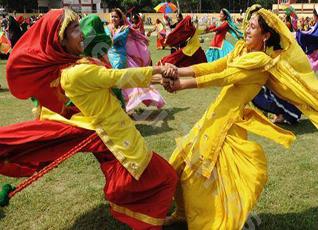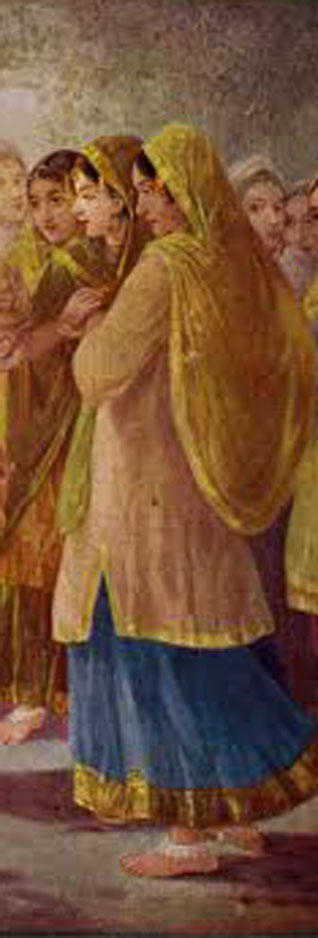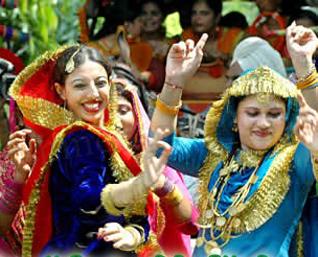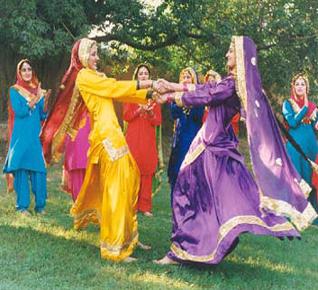Music
Giddha Comes Alive in Fiji
by JOGINDAR SINGH KANWAL
The festival of Vaisakhi will be celebrated in Fiji on April 14 this year.
On this occasion, along with prayers and kirtan in gurdwaras, two very popular dances, bhangra and giddha, are expected to be performed at some places.
Most of our people in Fiji, it is hoped, have enjoyed the bhangra performances at various festivals, fairs and carnivals but perhaps they may have not seen the giddha.
Lively and attractive, giddha is a folk dance of Punjabi women, the old and the young. Like the Fijian meke, it is graceful and is as rich in its rhythmical glamour as Fjian seasea and fan dances.
In both, meke and giddha, arm movements and hand gestures are fast and captivating and both these dances display feminine grace, elegance and charm but in giddha, sometimes body rhythms become unbelievably boisterous.
The folk dances, whether it is giddha, garba or meke, have travelled from one generation to another on the tracks of history and tradition.
The origin of giddha is associated with the ancient ring dance performed centuries ago in the region of undivided Punjab.
Its value as an entertainment must have gone deep down into the Punjabi psyche. That is why in the Sikh scripture, there are such striking references as nacchan kuddan munn ka chaao which means, 'dancing and playing are the heart's desire.'
These days giddha is performed vigorously not only during celebrations of the Vaisakhi festival but it is done at the time of marriages and on many other happy occasions.
Danced for sheer fun and enjoyment, it elevates the spirit not only of the participants but of the spectators also.
It is very popular in Punjab, its homeland, and in all those cities and towns of the world where Sikhs and Punjabis have settled in large numbers.
They promote this art through CDs, DVDs and Internet, and some of them do it with a missionary zeal because it relates to their identity and cultural heritage.
Although giddha has the same intensity as bhangra depicts, it has not yet achieved the same prestige and prominence as bhangra enjoys.
One of the reasons may be that it is not as widely used in Bollywood films as bhangra.
Although they are using profusely, such Punjabi terms from giddha lyrics as shaawa shaawa, balley balley, dhola, mahia, sohiniay, balliay, chand mahi, munda, kuri, and other Punjabi words and phrases, they seldom introduce giddha proper in their dance sequences.
Many different ways are used to perform giddha.
To begin with, 10 or twelve young , energetic women stand in a circle.
They will sing a boli, (two or four lines from a Punjabi language folk song) and begin clapping and thumping their feet. Then two participants break the circle. Swinging and twisting their bodies, both of them come forward and begin to dance. The tempo of the claps of those standing in the circle increases.
The movements of the two dancers become faster.
As soon as boli-singing finishes, the dancers step back and join the circle. Then another pair come forward and begin to dance.
To express their emotions and to bring thrill and excitement, sometimes all of them, standing in the circle, will begin and continue dancing until they are completely exhausted and become breathless.
If available, a dholak, a small size drum, will be used otherwise an earthen pitcher takes its place.
In order to produce the desired rhythm, a pebble piece is struck on the body of the pitcher but hand-claps are considered better and more reliable alternatives than the pitcher or the dholak to match with their steps. In olden days, the giddha dress was quite simple. A dupatta (a scarf to cover the head), kameez (shirt) and shalwar were sufficient. What they needed then was soft ground under their feet in or outside a house.
On moonlit nights, they could not resist the temptation to come out in the open and dance in tune with nature.
But in recent years, giddha is becoming more sophisticated. The participants use earrings, anklets and many other ornaments to add glamour to their performances.
Some groups use services of the choreographers to bring innovation and freshness in their presentation.
In some of the sequences, Punjabi poetry couplets called boli or bolis portray an event or episode and the performers dramatize it through their actions
The following is an example of a boli:
Look look laaian pargat hoiyan, bajj gaiay dhol niggare
Sohinyaa aaja vey, rabb dub dian nu taaray
An unmarried girl falls in love with a boy of her age. Their affair remains a secret but when people in the village come to know about it, she goes out, sings and dances with other girls who belong to her giddha group: The above boli means:
"Our secret love affair is exposed now
Drums and naggarey are beaten by the people
Come, my love!
God always helps loving folk."
A young girl and boy are recently married but the boy has to leave home to go out to earn for the family. The girl feels the pangs of separation and longs for his arrival. She blames the mother-in-law for sending the boy away from her. She sings:
balley balley, sassay ni manga le put nu
rataan kaalin, kalli nu dar aabey
sassay ni manga le put nu
"O' my mother-in-law! call back your son
I am alone here
The dark nights are scaring me."
In Punjabi folk literature, there are thousands of couplets or stanzas that express deep human cravings and many of them are used by giddha dancers. To promote this art form giddha associations, clubs and societies have been formed across the Sikh diaspora.
In Fiji, the first generation of Sikh women who migrated to Fiji with their husbands during late 1930's and early 1940's used to perform it on the occasion of marriages.
The second generation preserved what their mothers gave them but the present generation is interested to dance more on Punjabi and Bollywood film songs. Efforts to keep the giddha tradition alive have continued to be made in Khalsa College, Ba, which is run by the Sikh Community of Fiji and also in the Fiji Multi-Ethnic Cultural Centre.
The old, traditional dances have been the product of the 'native soil' of every country but as villages are growing into towns, and towns into cities, the original art forms are gradually fading away.
Not only in Punjab, not only in Fiji, the process and pace of industrialization are making life of the people more mechanized and 'sophisticated' in many other countries also, and folk cultures are, therefore, being eclipsed with the smoke and pollution of urbanisation.
There is a strong need to keep them alive in their natural form.
The author is a former principal of Khalsa College, Ba, Fiji, and is a published author. He is the chairman of the Multi-Ethnic Cultural Centre, Ba.
[Courtesy: The Fiji Times]
April 9, 2011
Conversation about this article
1: Dev Singh (Miri, Sarawak), April 18, 2011, 1:04 AM.
What a wonderful thing - culture being preserved! Like us - we're only 50 families, yet we have managed to establish The Sarawak Sikh Association.






